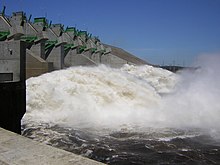|
Energy in Venezuela
 Venezuela was one of the world's largest producers of oil, and the country with the largest proven oil reserves in the world. Venezuela is a member of OPEC. Electricity in Venezuela is predominantly produced from hydroelectricity. Overview
OilVenezuela ranked 11th in the world for oil production in 2016; production has since fallen steeply.[2] The largest oil company is Petróleos de Venezuela (PDVSA). Oil fields in the country include Bolivar Coastal Field, Boscán Field, Maracaibo Basin and Orinoco Belt.
In 2023, Venezuela held the world's largest proven oil reserves at 303 billion barrels, accounting for 17% of global reserves, mostly extra-heavy crude from the Orinoco Belt. Despite this, production was only 0.8% of the global total, dropping to 742,000 barrels per day, a 70% decline from 2013. Production rose by 13% in 2021 and 18% in 2022 with help from Iran, China, and Chevron after some sanctions were eased. PDVSA, the state oil company, faces issues like heavy government levies, underinvestment, mismanagement, and a lack of skilled personnel, reducing reinvestment and production. Refineries operate below capacity due to maintenance issues and lack of feedstock. Venezuela relies on fuel imports from Iran and China due to domestic shortages. A territorial dispute with Guyana over the Essequibo region heightened tensions, but both countries agreed to seek a diplomatic resolution.[4] Natural gasIn 2023, Venezuela held 195 trillion cubic feet (Tcf) of natural gas reserves, making up 73% of South America's total. Most of this gas is associated with crude oil, with 80% produced as a by-product. Despite these vast reserves, much of Venezuela's natural gas is underutilized, used to support mature oil fields or flared due to inadequate infrastructure. Production peaked at 1.12 Tcf in 2001 but fell to 563 billion cubic feet (Bcf) by 2021, hampered by poor investment and lack of infrastructure. Domestic consumption peaked at 936 Bcf in 2015 but dropped to 563 Bcf by 2021 due to economic decline. Venezuela is a major gas flarer, with flaring increasing fourfold from 2012 to 2021, reaching 706 Bcf in 2022. Government-regulated prices and subsidies keep natural gas prices below market rates, further limiting investment in the sector.[4]
CoalIn 2021, Venezuela held South America's fourth-largest coal reserves, totaling 806 million short tons. The main coalfields are in Zulia State, near the Colombian border. Coal plays a minor role in Venezuela's energy mix, contributing 0.2% to total energy production and 0.1% to consumption. The coal industry faces challenges such as outdated infrastructure and limited investment, leading to a production decline of 16% annually from 2001 to 2021, after peaking at nearly 8.7 million short tons in 2000. By 2021, production was 174 thousand short tons, entirely bituminous coal. Most of Venezuela's coal is used domestically in industrial processes. Consumption peaked at 319,000 short tons in 2012 but dropped to 67,000 short tons by 2021 due to economic decline.[4]
Electricity HydroelectricityHydro power provided 74% of domestic electricity in 2008. Venezuela produced 87 TWh hydro power in 2008, 2.6% of the world total. Venezuela was top 8th in hydro electricity in 2008.[5] See alsoWikimedia Commons has media related to Energy in Venezuela. References
|
||||||||||||||||||||||||||||||||||||||||||||||||||||||||||||||||||||||||||||||||||||||||||||||||||||||||||||||||||||||||||||||||||||||||||||||||||||||